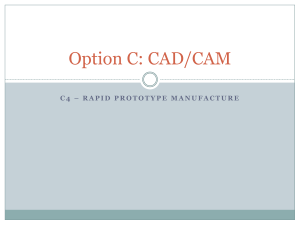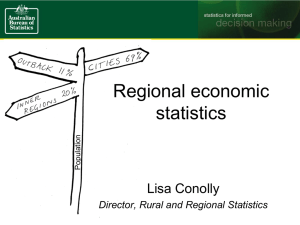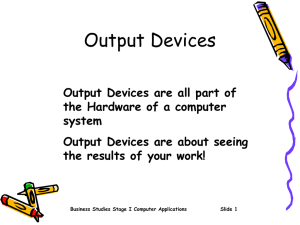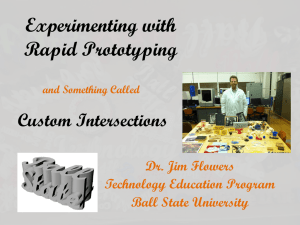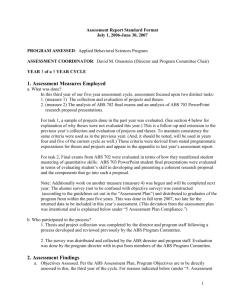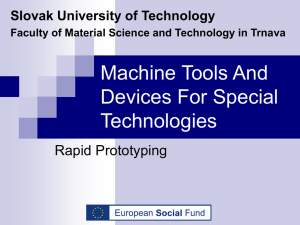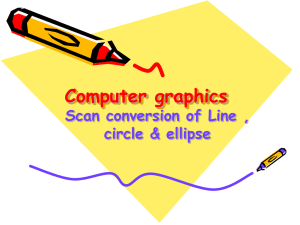3D-Printing
advertisement
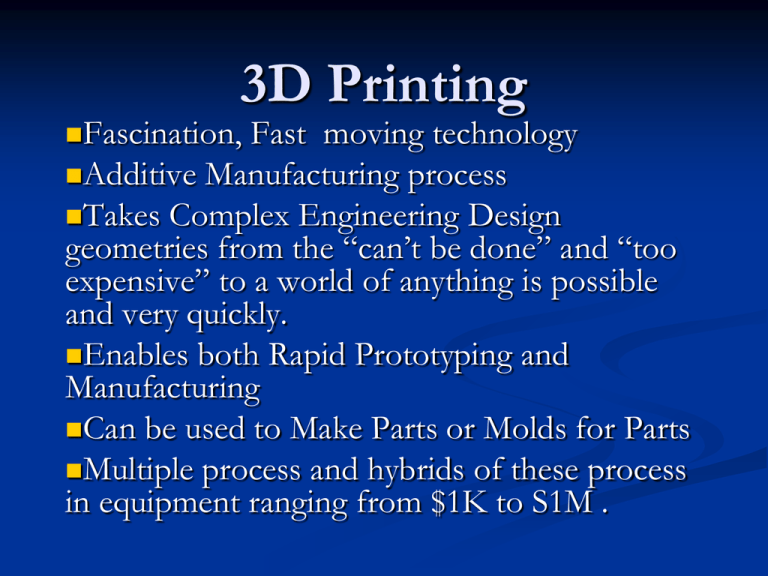
3D Printing Fascination, Fast moving technology Additive Manufacturing process Takes Complex Engineering Design geometries from the “can’t be done” and “too expensive” to a world of anything is possible and very quickly. Enables both Rapid Prototyping and Manufacturing Can be used to Make Parts or Molds for Parts Multiple process and hybrids of these process in equipment ranging from $1K to S1M . AGENDA About 3D Printing. STL, SLS, PloyJet, FDM-FFF, DLMS Home Printers - 2014 Best 3D Printers Solidoodle – Down and Dirty Demo Types of 3D Printing STL Stereolithography (SLA) is often considered the pioneer of the additive manufacturing processes, with the first production systems introduced in 1988 and patented by 3D systems founder Charles (Chuck) W. Hull. The SLA process utilizes a vat of liquid photopolymer resin cured by ultraviolet laser to solidify the pattern layer by layer to create or “print” a solid 3D model. An Ultra Violet (UV) laser beam is directed by a computer guided mirror onto the surface of the UV photopolymer resin. The model is built one layer at a time from supplied 3D CAD data. Materials: ABS, PE (Somos 8110), PC, PP-Like (Accura 25 / VisiJet SL Flex) Benefits: Higher precision, Smooth surface finish, Wide variety of material and post processing options Types of 3D Printing SLS Selective Laser Sintering (SLS) is an additive manufacturing technology developed under sponsorship by the Defense Advanced Research Projects Agency (DARPA) and acquired in 2001 by 3D Systems. Selective Laser Sintering (SLS) uses high power CO2 lasers (carbon dioxide laser) to fuse plastic, metal or ceramic powder particles together, layer-by-layer, to form a solid model. The system consists of a laser, part chamber, and control system. The part chamber consists of a build platform, powder cartridge, and leveling roller. A thin layer of build material is spread across the platform where the laser traces a twodimensional cross section of the part, sintering the material together. The platform then descends a single layer thickness and the leveling roller pushes material from the powder cartridge across the build platform, a the next cross section is sintered to the previous. This process is repeated one slice at a time until the part build height is completed. • Materials: Aluminum-Filled, Carbon Fiber Filled Nylon, Glass-Filled Nylon, ImpactResistant Rubber-Like • Benefits: Durable, functional parts with high complex geometries, Ideal for parts with high heat requirements or chemical resistance, Capable of producing parts with mechanical joints, snap fits or living hinges, Wide variety of materials and post processing options Types of 3D Printers - PolyJet The PolyJet rapid prototyping process uses high resolution ink-jet technology combined with UV curable materials to quickly and economically produce highly detailed and accurate physical prototypes in multiple colors and materials. Objet was founded in 1998 and the PolyJet IP developed by Rami Bonen, Gershon Miller and Hanan Gotaiit. 2012 Objet announced that it agreed to merge with privately held Stratasys. Objet Geometries has partnered with SOLIDWORKS to interface their design software with Objet’s Connex500 system. The co-developed software add-in allows significantly more control over end to end modeling preferences. Materials: Wide range of Materials and Colors with the Polycarbonate family. Benefits: Over molding. Can print range of colors and material at one time Types of 3D Printers - FDM Fused Deposition Modeling (FDM) is an additive manufacturing technology commonly used for modeling, prototyping, and production applications. FDM works on an "additive" principle by laying down material in layers; a plastic filament or metal wire is unwound from a coil and supplies material to produce a part. The technology was developed by S. Scott Crump in the late 1980s and was commercialized in 1990. The term fused deposition modeling and its abbreviation to FDM are trademarked by Stratasys Inc. The exactly equivalent term, fused filament fabrication (FFF), was then used to give a phrase that would be legally unconstrained in its use. Materials: ABS, PLA, Polycarbonate, Polyamides, Polystyrene, Lignin, among many others. Benefits: With suitable material selection can be used for Fit, Form and Function. Types of 3D Printers – DLMS Direct Laser Metal Sintering The DMLS machine uses a high-powered 200 watt Ybfiber optic laser. Inside the build chamber area, there is a material dispensing platform and a build platform along with a recoater blade used to move new powder over the build platform. The technology fuses metal powder into a solid part by melting it locally using the focused laser beam. Parts are built up additively layer by layer, typically using layers 20 micrometres thick Personal Printers – Typical Specs. What to watch for Mostly FFF (Fused Filament Fabrication processing). Single or Twin Extruders. Single extruder uses same material for support. Print Sizes vary and are somewhat limited. Enclosure. Helps temperature stability Heater print bed- Essential for ABS Extruder type- Nice to have an extruder that can handle both PLA or ABS. Slicing Software: Proprietary or Open Source. Open source does not get much support from the author. Support and Service for the printer hardware and firmware. Materials and Costs. Mostly ABS or PLA Thermoplastic Filaments. Difference between ABS and PLA ABS - Acrylonitrile Butadiene Styrene. It's strength, flexibility, machinability, and higher temperature resistance make it often a preferred plastic for engineers, and professional applications. The hot plastic smell deter some as does the plastics petroleum based origin. The additional requirement of a heated print bed means there are some printers simply incapable of printing ABS with any reliability. PLA - Polylactic Acid .The wide range of available colors and translucencies and glossy feel often attract those who print for display or small household uses. Many appreciate the plant based origins and prefer the semi-sweet smell over ABS. When properly cooled, PLA seems to have higher maximum printing speeds, lower layer heights, and sharper printed corners. Combining this with low warping on parts make it a popular plastic for home printers, hobbyists, and schools. 2014 BEST 3D Printers Product Comparisons 1. 2. 3. 4. 5. 6. 7. 8. 9. 10. Ultimaker 2 Cubify CubeX Cubify Cube Airwolf AW3D HD Ditto + AW3D XL MBot Cube II Replicator 2X Litto MBot Cube $2,600.00 $2,499.00 $1,123.15 $2,995.00 $1,249.00 $2,399.00 $1,507.60 $2,199.00 $999.00 $1,199.00 Solidoodle SD 3DP Price $800 Material- ABS Heated Bed 8” x 8” (x 8”) No Enclosure on this model, so made my own. Added a Borosilicate glass plate to the bed to eliminate the warpage on the existing Al bed plate. Needed to calibrate nozzle and adjust everything before printing. Primary source on information from the SolidForm.com (3D Printer Community). Steep learning curve in finding the best way to make ABS stick to the build plate and eliminate warping. Still working on optimizing slicer software. Solidoodle are responsive to service calls but not helpful on slicer settings In Conclusion 3D Printing is developing very rapidly. Performance improving and cost coming down. If your planning on investing in a Business Printer- Do your homework If you’re thinking a Home PrinterDo your homework. Despite all of the challenges it been a bundle of fun.

